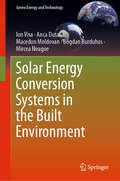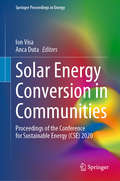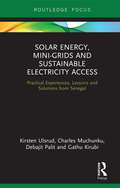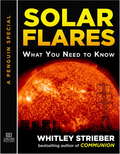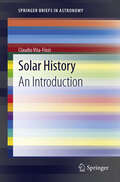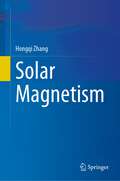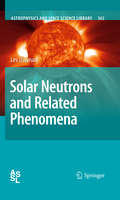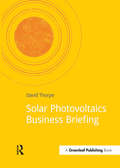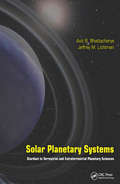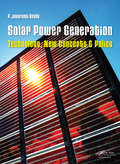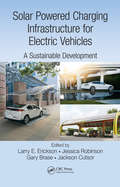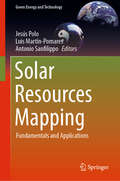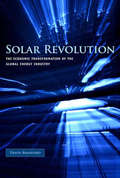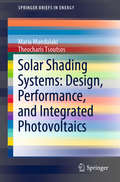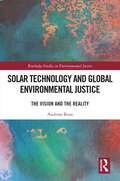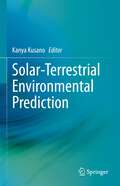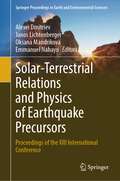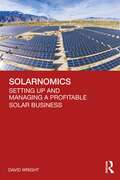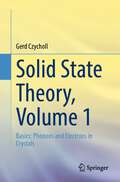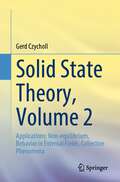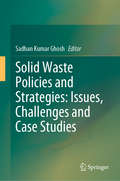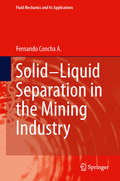- Table View
- List View
Solar Energy Conversion Systems in the Built Environment (Green Energy and Technology)
by Ion Visa Anca Duta Macedon Moldovan Bogdan Burduhos Mircea NeagoeThis book focuses on solar energy conversion systems that can be implemented in the built environment, at building or at community level. The quest for developing a sustainable built environment asks for specific solutions to provide clean energy based on renewable sources, and solar energy is considered one of the cleanest available energy on Earth. The specific issues raised by the implementation location are discussed, including the climatic profile distorted by the buildings, the available surface on the buildings for implementation, etc. This book also discusses the seasonal and diurnal variability of the solar energy resource in parallel with the variability of the electrical and thermal energy demand in the built environment (particularly focusing on the residential buildings). Solutions are proposed to match these variabilities, including the development of energy mixes with other renewables (e.g. geothermal or biomass, for thermal energy production). Specific solutions, including case studies of systems implemented on buildings all over the world, are presented and analyzed for electrical and for thermal energy production and the main differences in the systems design are outlined. The conversion efficiency (thus the output) and the main causes of energy losses are considered in both cases. The architectural constraints are additionally considered and novel solar energy convertors with different shapes and colors are presented and discussed. The durability of the solar energy conversion systems is analyzed considering the specific issues that occur when these systems are implemented in the built environment; based on practical examples, general conclusions are formulated and specific aspects are discussed in relation to experimental results and literature data. With renewables implemented in the built environment likely to expand in the near future, this book represents welcome and timely material for all professionals and researchers that are aiming to provide efficient and feasible solutions for the sustainable built environment.
Solar Energy Conversion in Communities: Proceedings of the Conference for Sustainable Energy (CSE) 2020 (Springer Proceedings in Energy)
by Ion Visa Anca DutaThis book presents novel findings concerning the systems, materials and processes used in solar energy conversion in communities. It begins with the core resource – solar radiation – and discusses the restrictions on the wide-scale implementation of conversion systems imposed by the built environment, as well as potential solutions. The book also describes efficient solar energy conversion in detail, focusing on heat and electricity production in communities and water reuse. Lastly, it analyzes the concept of sustainable communities, presenting examples from around the globe, along with novel approaches to improving their feasibility and affordability. Though chiefly intended for professionals working in the field of sustainability at the community level, the book will also be of interest to researchers, academics and doctoral students.
Solar Energy, Mini-grids and Sustainable Electricity Access: Practical Experiences, Lessons and Solutions from Senegal (Routledge Focus on Environment and Sustainability)
by Debajit Palit Kirsten Ulsrud Charles Muchunku Gathu KirubiThis book presents new research on solar mini-grids and the ways they can be designed and implemented to provide equitable and affordable electricity access, while ensuring economic sustainability and replication. Drawing on a detailed analysis of solar mini-grid projects in Senegal, the book provides invaluable insights into energy provision and accessibility which are highly relevant to Sub-Saharan Africa, and the Global South more generally. Importantly, the book situates mini-grids in rural villages within the context of the broader dynamics of national- and international-level factors, including emerging system innovation and socio-technical transitions to green technologies. The book illustrates typical challenges and potential solutions for practitioners, policymakers, donors, investors and international agencies. It demonstrates the decisive roles of suitable policies and regulations for private-sector-led mini-grids and explains why these policies and regulations must be different from those that are designed as part of an established, centralized electricity regime. Written by both academics and technology practitioners, this book will be of great interest to those researching and working on energy policy, energy provision and access, solar power and renewable energy, and sustainable development more generally.
Solar Flares: What You Need to Know
by Whitley StrieberThere is a force out there that could destroy our world in minutes. . . .Solar flares--brief bursts of radiation from our sun--have always existed and have never been particularly dangerous. Nature hasn't changed. But we have. <P><P>By making our world so dependent on electricity delivered by huge, unprotected power grids we have inadvertently placed humanity at terrible risk. As bestselling author Whitley Strieber explores in this urgent new work, a powerful solar flare could demolish our electrical delivery system, wiping away centuries of civilization in minutes and drastically changing our world.Such a scenario is altogether plausible--and it is the single most dangerous single thing that could happen to our civilization, more dangerous than the most massive earthquake or volcano, more dangerous than climate change, more dangerous even than nuclear war. What is worse, solar flares of a now-dangerous intensity are not all that uncommon; and not only that, our electrical and electronic infrastructure is becoming so extensive, and thus so fragile, that smaller and smaller solar flares can pose more and more serious hazards.<P>Due to the astonishing unwillingness of power companies to cooperate, good programs that would make us safer, and that are supported by both political parties, have been routinely prevented from being enacted.In Solar Flares: What You Need to Know, Strieber reveals the dangers behind solar flares, tracks the disastrous damage they could cause, surveys what they would do to our world in the here-and-now, and explains what nations and individuals must do to prepare for them.
Solar History
by Claudio Vita-FinziBeyond the four centuries of sunspot observation and the five decades during which artificial satellites have monitored the Sun - that is to say for 99.99999% of the Sun's existence - our knowledge of solar history depends largely on analogy with kindred main sequence stars, on the outcome of various kinds of modelling, and on indirect measures of solar activity. They include the analysis of lunar rocks and meteorites for evidence of solar flares and other components of the solar cosmic-ray (SCR) flux, and the measurement of cosmogenic isotopes in wood, stratified ice and marine sediments to evaluate changes in the galactic cosmic-ray (GCR) flux and thus infer changes in the sheltering magnetic fields of the solar wind. In addition, shifts in the global atmospheric circulation which appear to result from cyclic fluctuations in solar irradiance have left their mark in river sediments and in the isotopic composition of cave deposits. In this volume the results these sources have already produced have been summarised, paying special attention to those that reflect processes in different parts of the Sun's interior and that display periodicities and trends which may enable us to forecast future large-scale environmental changes.
Solar Home Design Manual for Cool Climates
by Shawna Henderson Don RoscoeIf you want an inexpensive, environmentally sound source of energy for your home, you need look no further than the sun. Solar heat is not subject to rate increases, is totally renewable, pollution free and requires little or no technology. It is here for you today, and can easily provide up to 50% of your space and water heating requirements. This is a book that simply and clearly explains the principles of using solar energy to heat your home. Anyone building a new home, or renovating an old one can incorporate one or several aspects of solar energy into their design. Taking you through the process of designing a solar home from the ground up this manual is also a basic course in conservation and sustainable house design. If you live in a 'heating' climate, meaning if you have space heating requirements for most of the year then this is an invaluable resource. A house is the biggest single investment most of us will make in our lives - the way it is built and how it operates can reflect a long term investment in both the building and the planet.
Solar Magnetism
by Hongqi ZhangThis book highlights fundamentals and advances in the theories and observations of solar magnetic fields. Solar magnetism is an important part of solar physics and space weather research. It covers the formation, development, and relaxation of the magnetic fields in the solar eruptive process. The book discusses topics ranging from measurement facilities for solar observations to the evolution of solar magnetic fields, the storage of magnetic energy, and the magnetic helicity in the solar atmosphere and its relation with solar cycles. The book also presents recent advances in measurements and observations of solar magnetic shear, currents, magnetic helicity, and solar cycles. The book intends for astronomy-majored students and researchers interested in solar magnetism and its role in astrophysics.
Solar Neutrons and Related Phenomena
by Lev DormanThis book presents the first comprehensive compilation and review of the extensive body of experimental and theoretical material on solar neutrons and related phenomena published in the scientific literature over the last sixty years. Phenomena related to solar neutrons are more specifically: - the decay products of solar neutrons - solar gamma rays generated in processes like nuclear reactions between solar energetic charged particles and matter of the solar atmosphere, as well as by the capture of solar neutrons by hydrogen atoms in the solar atmosphere - the propagation of solar neutrons, solar gamma rays and other secondary particles through the solar photosphere, chromosphere and corona, as well as through interplanetary space and through the Earth's atmosphere. Models and simulations of particle acceleration, interactions, and propagation processes show that observations of solar neutrons and gamma rays in space and in the Earth's atmosphere yield essential and unique information on the source function of energetic solar particles, as well as on the chemical composition and density distribution of plasma in the solar atmosphere. The results described in the book may also be useful for astrophysical studies of other stars and different astrophysical objects, as well as for space weather problems. The book will serve as a reference work for researchers and students in solar physics, plasma, neutron, and gamma ray physics, as well as in cosmic ray physics, space science, geophysics and those researching space weather problems.
Solar Photovoltaics Business Briefing (Doshorts Ser.)
by David ThorpeThis book explains, for a UK business audience, the technical, scientific and economic aspects of solar photovoltaics (PV) technologies. It is useful to anyone considering a business use of solar PV, whether an investor, potential purchaser, or thinking of setting up a company in the sector.It succinctly examines: their applications and how to assess them; the prospects and drivers for cost reductions and implementation; the role of PV in carbon offsetting; and the business case for and against investment.It will arm the reader with sufficient knowledge to talk to contractors or to compile a business investment case for senior management.PV is the sunrise sector for electricity generation; the renewable technology whose time has come. Clean, and with no moving parts to wear out, it interfaces neatly with other technologies, both digital and analogue. Cost curves are decreasing and installation curves exponentially rising. Although silicon-based cells are well-known, due to the feed-in tariff support they receive, within the next five to eight years, lowering production costs and technological innovations will mean that solar electricity will be poised to find even more widespread applications.
Solar Planetary Systems: Stardust to Terrestrial and Extraterrestrial Planetary Sciences
by Asit B. Bhattacharya Jeffrey M. LichtmanThe authors have put forth great efforts in gathering present day knowledge about different objects within our solar system and universe. This book features the most current information on the subject with information acquired from noted scientists in this area. The main objective is to convey the importance of the subject and provide detailed information on the physical makeup of our planetary system and technologies used for research. Information on educational projects has also been included in the Radio Astronomy chapters.This information is a real plus for students and educators considering a career in Planetary Science or for increasing their knowledge about our planetary system.
Solar Power Generation: Technology, New Concepts & Policy
by P. Jayarama ReddyThis book offers a global perspective of the current state of affairs in the field of solar power engineering. In four parts, this well-researched volume informs about:Established solar PV (photovoltaic) technologiesThird-generation PV technologies based on new materials with potential for low-cost large-scale productionSolar cell technology based
Solar Powered Charging Infrastructure for Electric Vehicles: A Sustainable Development
by David Morley, Xiaoming Li, Crispin JenkinsonThe Paris Agreement on Climate Change adopted on December 12, 2015 is a voluntary effort to reduce greenhouse gas emissions. In order to reach the goals of this agreement, there is a need to generate electricity without greenhouse gas emissions and to electrify transportation. An infrastructure of SPCSs can help accomplish both of these transitions. Globally, expenditures associated with the generation, transmission, and use of electricity are more than one trillion dollars per year. Annual transportation expenditures are also more than one trillion dollars per year. Almost everyone will be impacted by these changes in transportation, solar power generation, and smart grid developments. The benefits of reducing greenhouse gas emissions will differ with location, but all will be impacted. This book is about the benefits associated with adding solar panels to parking lots to generate electricity, reduce greenhouse gas emissions, and provide shade and shelter from rain and snow. The electricity can flow into the power grid or be used to charge electric vehicles (EVs). Solar powered charging stations (SPCSs) are already in many parking lots in many countries of the world. The prices of solar panels have decreased recently, and about 30% of the new U.S. electrical generating capacity in 2015 was from solar energy. More than one million EVs are in service in 2016, and there are significant benefits associated with a convenient charging infrastructure of SPCSs to support transportation with electric vehicles. Solar Powered Charging Infrastructure for Electric Vehicles: A Sustainable Development aims to share information on pathways from our present situation to a world with a more sustainable transportation system with EVs, SPCSs, a modernized smart power grid with energy storage, reduced greenhouse gas emissions, and better urban air quality. Covering 200 million parking spaces with solar panels can generate about 1/4 of the electricity that was generated in 2014 in the United States. Millions of EVs with 20 to 50 kWh of battery storage can help with the transition to wind and solar power generation through owners responding to time-of-use prices. Written for all audiences, high school and college teachers and students, those in industry and government, and those involved in community issues will benefit by learning more about the topics addressed in the book. Those working with electrical power and transportation, who will be in the middle of the transition, will want to learn about all of the challenges and developments that are addressed here.
Solar Resources Mapping: Fundamentals and Applications (Green Energy and Technology)
by Jesús Polo Luis Martín-Pomares Antonio SanfilippoThis book presents methods for optimising the spatial and network configuration of solar radiation measuring stations. Various physical and mathematical models are demonstrated, which together with high quality measurements, provide the essential tools to generate and validate solar resource estimates to improve the mapping of solar resources.Each chapter deals with a specific topic, showing its methodology, and providing examples of how to apply these techniques with reference to current projects around the world. These topics include:· Radiometric measurement campaigns;· Equipment calibration, installation, operation, and maintenance;· Data quality assurance and assessment;· Solar radiation modelling from satellite images and numerical models;· Downscaling and kriging interpolation of solar radiation;· Simulation of electric solar power plant generation;· Solar radiation forecasting;· Applications of solar energy; and· Socio-economic benefits of solar energy.The contributors present the statistical and physical models needed to derive solar radiation from satellite images and numerical models, emphasising the importance of measuring solar radiation accurately. They also show the classical models used to generate synthetic data, clear sky models and ancillary air quality and meteorological data from different input sources.Solar Resources Mapping provides industry professionals with methodologies and tools to build solar irradiance maps for different applications. The book will also benefit students and researchers as it serves as a main technical reference, presenting the basic terminology and fundamentals for solar resource mapping that include methods for assessing measurement uncertainty.
Solar Revolution: The Economic Transformation of the Global Energy Industry (The\mit Press Ser.)
by Travis BradfordAn innovative analysis that shows how the shift to solar energy—in particular, the use of photovoltaic cells—is both economically advantageous and inevitable, and will rival the information and communication technologies revolution in its transformative effects.In Solar Revolution, fund manager and former corporate buyout specialist Travis Bradford argues—on the basis of standard business and economic forecasting models—that over the next two decades solar energy will increasingly become the best and cheapest choice for most electricity and energy applications. Solar Revolution outlines the path by which the transition to solar technology and sustainable energy practices will occur.Developments in the photovoltaic (PV) industry over the last ten years have made direct electricity generation from PV cells a cost-effective and feasible energy solution, despite the common view that PV technology appeals only to a premium niche market. Bradford shows that PV electricity today has become the choice of hundreds of thousands of mainstream homeowners and businesses in many markets worldwide, including Japan, Germany, and the American Southwest. Solar energy will eventually be the cheapest source of energy in nearly all markets and locations because PV can bypass the aging and fragile electricity grid and deliver its power directly to the end user, fundamentally changing the underlying economics of energy. As the scale of PV production increases and costs continue to decline at historic rates, demand for PV electricity will outpace supply of systems for years to come. Ultimately, the shift from fossil fuels to solar energy will take place not because solar energy is better for the environment or energy security, or because of future government subsidies or as yet undeveloped technology. The solar revolution is already occurring through decisions made by self-interested energy users. The shift to solar energy is inevitable and will be as transformative as the last century's revolutions in information and communication technologies.
Solar Shading Systems: Design, Performance, and Integrated Photovoltaics (SpringerBriefs in Energy)
by Maria Mandalaki Theocharis TsoutsosThis is the first book to describe the development of and state of the art in solar shading devices in buildings, detailing all methods of evaluating shading systems according to thermal and visual comfort. The issue of energy balance in buildings is gaining importance as conventional energy sources dwindle and become more expensive. As such, environmental concerns should be considered in overall design decisions. The book discusses the role sun control “machines” play in controlling solar and thermal radiation. It examines their geometry, their position in relation to glazing and their operation (in the cases of movable systems) to control the heat and light entering a building, as well as how their material and color influence their performance. This book appeals to architects and designers who are interested in efficient energy facade design.
Solar Technology and Global Environmental Justice: The Vision and the Reality (Routledge Studies in Environmental Justice)
by Andreas RoosBuilding on insights from ecological economics and philosophy of technology, this book offers a novel, interdisciplinary approach to understand the contradictory nature of Solar photovoltaic (PV) technology. Solar photovoltaic (PV) technology is rapidly emerging as a cost-effective option in the world economy. However, reports about miserable working conditions, environmentally deleterious mineral extraction and toxic waste dumps corrode the image of a problem-free future based on solar power. Against this backdrop, Andreas Roos explores whether ‘ecologically unequal exchange’ – an asymmetric transfer of labour time and natural resources – is a necessary condition for solar PV development. He demonstrates how the massive increase in solar PV installation over recent years would not have been possible without significant wage/price differences in the world economy - notably between Europe/North America and Asia- and concludes that solar PV development is currently contingent on environmental injustices in the world economy. As a solution, Roos argues that solar technology is best coupled with strategies for degrowth, which allow for a transition away from fossil fuels and towards a socially just and ecologically sustainable future. This book will be of great interest to students and scholars of solar power, philosophy of technology, and environmental justice.
Solar-Terrestrial Environmental Prediction
by Kanya KusanoPowerful solar explosions, such as flares and coronal mass ejections, greatly disturb the electromagnetic environment around the Earth and the atmosphere. They may even impact various social systems—communications, positioning, electric power supply, aviation and activities in space. Such variations in the space environment, which can influence human activities, are called “space weather.” The space weather disaster caused by a solar explosion is a potential risk in modern society. To reduce and mitigate space weather impacts, it is essential to understand the structure and dynamics of the solar–terrestrial environment and to predict the variations. This book comprehensively describes space weather, from the basics of related sciences to the possible social impacts. It was compiled based on a national research project on solar–terrestrial environment prediction conducted in Japan recently. It consists of four parts: the linkage between space weather and society; the magnetosphere of the Earth and space weather prediction; solar storms and space weather prediction; and long-term prediction of solar cycle activity and climate impacts. Each chapter covers the basics and applications of each area, which helps readers gain a broad understanding of the subject matter throughout the book. In addition, readers are able to select and read the topics they are most interested in. It is especially valuable for undergraduate and graduate students and young researchers studying space weather and related topics, and is further helpful for experts in various industries related to space weather disasters. The translation was done with the help of artificial intelligence (machine translation by the service DeepL.com). The present version has been revised technically and linguistically by the authors in collaboration with a professional translator.
Solar-Terrestrial Relations and Physics of Earthquake Precursors: Proceedings of the XIII International Conference (Springer Proceedings in Earth and Environmental Sciences)
by Alexei Dmitriev Janos Lichtenberger Oksana Mandrikova Emmanuel NahayoThis book contains the papers selected by the Scientific Committee and represented at the XIII International Conference "Solar-Terrestrial Relations and Physics of Earthquake Precursors", which was hold at the Institute of Cosmophysical Research and Radio Wave Propagation, Far Eastern Branch of the Russian Academy of Sciences, Kamchatka. The papers describe the investigation results in the fields of atmosphere, ionosphere and magnetosphere physics. Mechanisms of transformation of solar wind energy into the energy of magnetospheric-ionospheric processes, effects of the processes in the Earth core on the lower and upper atmosphere, seismo-electromagnetic, seismo-electric and seismo-acoustic effects at different frequency ranges in the Earth crust, atmosphere and ionosphere are under consideration. Modern methods for geophysical data collection, processing, transfer and exchange as well as organisation issues of seismic activity monitoring are presented.The Conference "Solar-Terrestrial Relations and Physics of Earthquake Precursors" has 25 years of history. Scientists from Russia, Japan, Hungary, China, India, USA and other countries participate in it. In a traditional way, the Conference includes three sections: atmosphere physics, geophysical fields and their interaction, physics of earthquake precursors.
Solarnomics: Setting Up and Managing a Profitable Solar Business
by David WrightSolar power has come of age. Not only has it become one of the key alternatives to fossil fuels, it can now be deployed in a way that makes a viable business with a financial profit. This book shows industry professionals and students how to do just that. Solarnomics describes the economics of building and operating a solar power plant today and provides a window into a future in which several technologies collaborate, and in which all participants in the electricity grid become smarter at scheduling both the supply and demand for electric power to give humanity a future that is sustainable, both environmentally and economically. The book shows how to estimate costs and revenues, how to tweak the design of a project to improve profitability, how to calculate return on investment, how to assess and deal with risk, how to raise capital, how to combine solar with batteries to make a hybrid microgrid, and how to be prepared for future developments in the evolving smart electricity grid. Solarnomics will enable professionals in the solar industry to assess the potential profitability of a proposed solar project, and it will enable students to add an extra dimension to their understanding of sustainability.
Solid State Theory, Volume 1: Basics: Phonons and Electrons in Crystals
by Gerd CzychollThe textbooks “Solid State Theory" give an introduction to the methods, contents and results of modern solid state physics in two volumes. This first volume has the basic courses in theoretical physics as prerequisites, i.e. knowledge of classical mechanics, electrodynamics and, in particular, quantum mechanics and statistical physics is assumed. The formalism of second quantization (occupation number representation), which is needed for the treatment of many-body effects, is introduced and used in the book. The content of the first volume deals with the classical areas of solid state physics (phonons and electrons in the periodic potential, Bloch theorem, Hartree-Fock approximation, density functional theory, electron-phonon interaction). The first volume is already suitable for Bachelor students who want to go beyond the basic courses in theoretical physics and get already familiar with an application area of theoretical physics, e.g. for an elective subject "Theoretical (Solid State) Physics" or as a basis for a Bachelor thesis. Every solid-state physicist working experimentally should also be familiar with the theoretical methods covered in the first volume. The content of the first volume can therefore also be the basis for a module "Solid State Physics" in the Master program in Physics or, together with the content of the 2nd volume, for a module "Theoretical Solid State Physics" or "Advanced Theoretical Physics". The following second volume covers application areas such as superconductivity and magnetism to areas that are current research topics (e.g. quantum Hall effect, high-temperature superconductivity, low-dimensional structures).
Solid State Theory, Volume 2: Applications: Non-equilibrium, Behavior in External Fields, Collective Phenomena
by Gerd CzychollThe present volume 2 covers advanced topics in theoretical solid state physics and thus ties in directly with the fundamentals. Solids in external fields or more generally in non-equilibrium and deviations from the ideal 3-dimensional crystal structure (surfaces, impurities, low-dimensional structures, quantum dots, etc.) are treated. The consideration of collective phenomena such as superconductivity and magnetism complete the presentation. The reader is assumed to have the contents of Volume 1 (electrons and phonons in ideal crystals, Bloch theorem, population number representation or 2nd quantization, electron-electron and electron-phonon interaction) as well as the basic knowledge of general theoretical physics (mechanics, electrodynamics, quantum mechanics, and statistical physics) usually available after a bachelor's degree in physics. Volume 2 is thus ideally suited for students in the master's program in physics who wish to specialize in (experimental or theoretical) solid-state physics. Addressing current topics (e.g., Kondo effect, fractional quantum Hall effect, 2-dimensional crystals such as graphene, giant magnetoresistance effect, and others) provides an optimal transition to modern research.The new edition has been completely revised, expanded with numerous exercises and existing redesigned, with the associated solutions now included in the book.
Solid Waste Management: Principles and Practice (Environmental Science and Engineering)
by Ramesha Chandrappa Diganta Bhusan DasThis book discusses solid waste management issues from global to local level. It offers an overview of the methods and paradigms of this burgeoning field, ranging from generation, characteristics, quantity, and practical challenges. The book discusses the major issues with respect to environmental health and economy, which are related to solid waste management. Furthermore, it contains updated information on topics such as toxicology, climate change, population pressure, urbanization, energy production, building and community design, and disaster preparedness in the context of solid waste management.
Solid Waste Policies and Strategies: Issues, Challenges and Case Studies
by Sadhan Kumar GhoshThe book focuses on the challenges faced by urban areas in the context of handling waste in an environmentally and socially acceptable manner. It also discusses effective waste management approaches, which differ according to culture, climate, and socio-economic variables, as well as institutional volume. Presenting selected, high-quality papers from IconSWM 2018, the book explores a number of waste management methods with the help of case studies.
Solid Wood: Case Studies in Mass Timber Architecture, Technology and Design
by Joseph MayoOver the past 10-15 years a renaissance in wood architecture has occurred with the development of new wood building systems and design strategies, elevating wood from a predominantly single-family residential idiom to a rival of concrete and steel construction for a variety of building types, including high rises. This new solid wood architecture offers unparalleled environmental as well as construction and aesthetic benefits, and is of growing importance for professionals and academics involved in green design. Solid Wood provides the first detailed book which allows readers to understand new mass timber/massive wood architecture. It provides: historical context in wood architecture from around the world a strong environmental rationale for the use of wood in buildings recent developments in contemporary fire safety and structural issues insights into building code challenges detailed case studies of new large-scale wood building systems on a country-by-country basis. Case studies from the UK, Norway, Sweden, Germany, Austria, Italy, Canada, the United States, New Zealand and Australia highlight design strategies, construction details and unique cultural attitudes in wood design. The case studies include the most ambitious academic, hospitality, industrial, multi-family, and wood office buildings in the world. With discussions from leading architectural, engineering, and material manufacturing firms in Europe, North America and the South Pacific, Solid Wood disrupts preconceived notions and serves as an indispensable guide to twenty-first century wood architecture and its environmental and cultural benefits.
Solid-Liquid Separation in the Mining Industry
by Fernando Concha A.This book covers virtually all of the engineering science and technological aspects of separating water from particulate solids in the mining industry. It starts with an introduction to the field of mineral processing and the importance of water in mineral concentrators. The consumption of water in the various stages of concentration is discussed, as is the necessity of recovering the majority of that water for recycling. The book presents the fundamentals under which processes of solid-liquid separation are studied, approaching mixtures of discrete finely divided solid particles in water as a basis for dealing with sedimentation in particulate systems. Suspensions, treated as continuous media, provide the basis of sedimentation, flows through porous media and filtration. The book also considers particle aggregations, and thickening is analyzed in depth. Lastly, two chapters cover the fundamentals and application of rheology and the transport of suspensions. This work is suitable for researchers and professionals in laboratories and plants, and can also serve as additional reading for graduate courses on solid liquid separation as well as for advanced undergraduate and graduate level students for courses of fluid mechanics, solid-liquid separation, thickening, filtration and transport of suspensions in tubes and channels.
